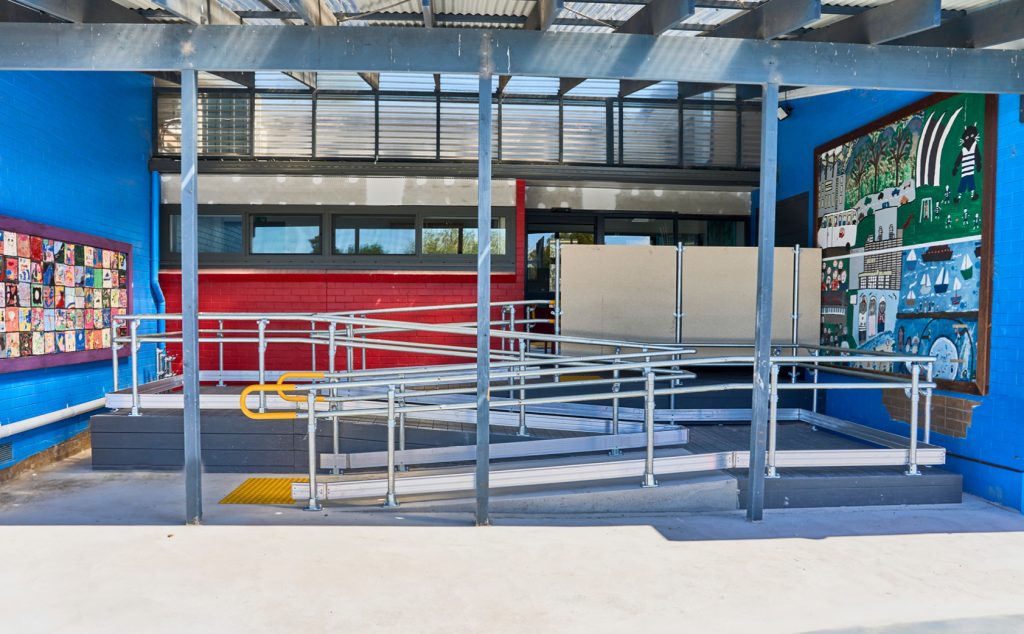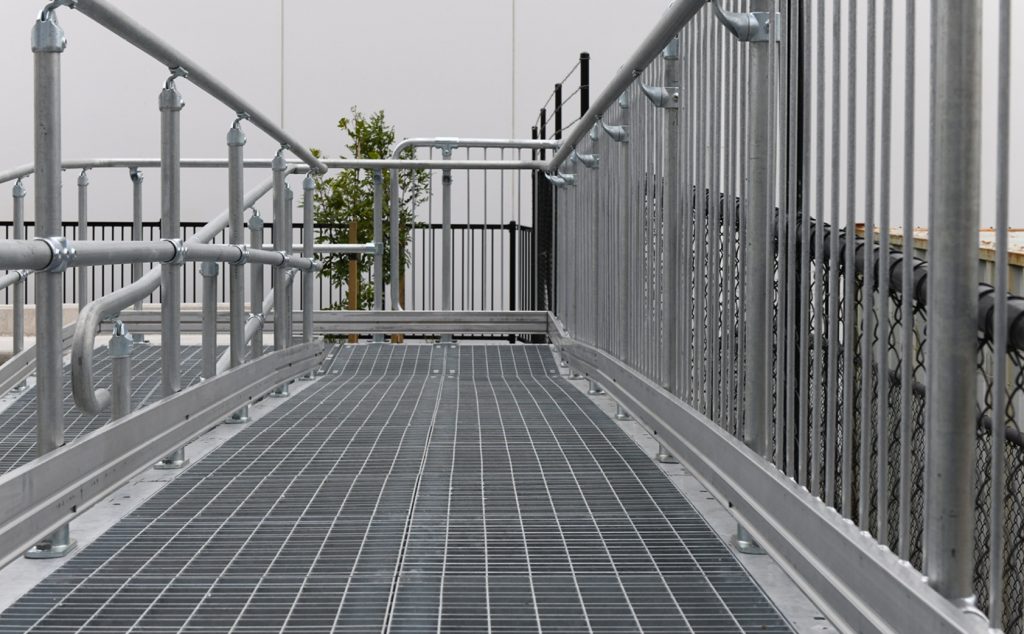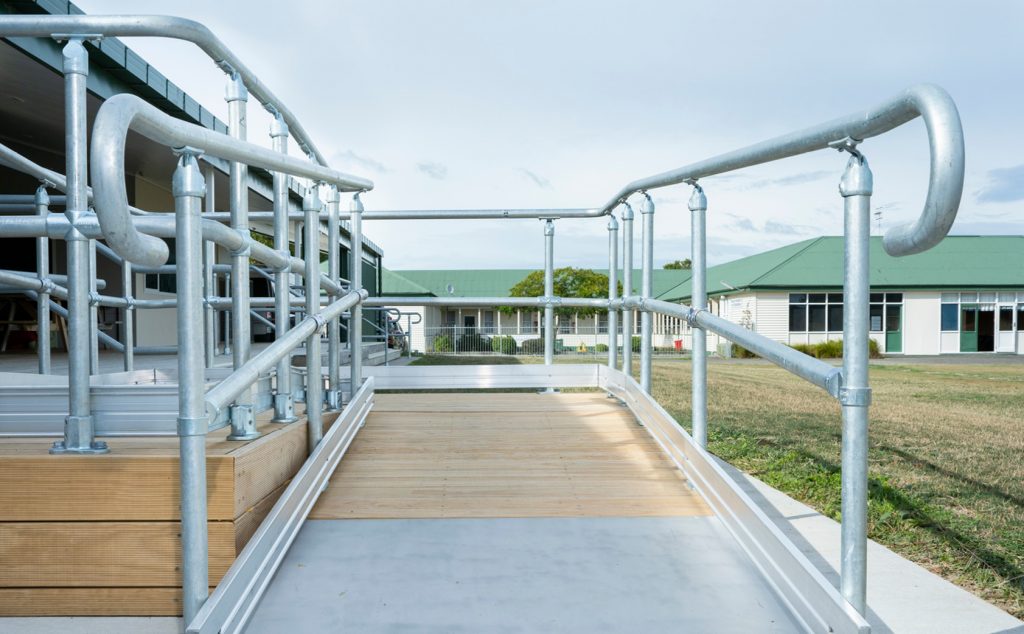In today’s world, accessibility is a fundamental aspect of public and commercial spaces. The Disability Discrimination Act (DDA) and AS1428 standards promote inclusivity in design by establishing clear guidelines for accessible features like ramps and stairs, ensuring everyone can navigate buildings safely, including individuals with disabilities. However, not all ramps meet these stringent requirements, and if poorly designed, there could be serious emotional and financial cost associated with injury, permanent disability, or death should this design element be overlooked.
In this blog, we explore the top 5 key factors that make a ramp non-compliant and the importance of adhering to accessibility standards.

1. Incorrect Gradient
One of the key factors that can mean a ramp is non-compliant is an incorrect gradient. The gradient of a ramp is crucial for ensuring ease of use. Consistency in the gradient throughout the ramp’s length is essential, with a maximum allowable tolerance of 3%, as long as no section of the ramp is steeper than 1 in 14.
According to AS1428 standards:
- Ramps longer than 1900mm must have a maximum gradient of 1:14.
- Ramps shorter than 1900mm should not exceed a gradient of 1:10.
- Smaller threshold ramps should have a gradient no steeper than 1:8.
If the gradient exceeds these limits, the ramp becomes difficult and potentially hazardous for individuals with mobility impairments to navigate.

2. Inadequate Clear Width
DDA and AS1428 handrail compliance for disability ramps specifies a minimum clear width of 1000mm between handrails. If the ramp changes direction, the approaching angle to the landing should be 90° to facilitate smooth navigation. Non-compliance occurs if the width is reduced, making it difficult for individuals using wheelchairs or mobility aids to navigate the ramp comfortably.

3. Inadequate Landing Areas
Landings provide rest areas and are essential for safety on longer ramps. Non-compliance can occur if landings are improperly sized or omitted. Ramps must include landings at both the bottom and top, as well as at regular intervals.
AS1428 specifies that:
- For ramp gradients of 1 in 14, landings should be provided at intervals not exceeding 9m.
- For gradients steeper than 1 in 20, landings should be placed at intervals no greater than 15m.
- For gradients between 1 in 14 and steeper than 1 in 20, intervals are determined by linear interpolation.
- Landings must be at least 1200mm long for straight ramps and 1500mm for ramps with a change in direction exceeding 90°.
Ignoring these specifications results in non-compliance and reduced safety for ramp users.
4. No slip-resistant surfaces
A non-compliant ramp often lacks appropriate slip-resistant surfaces. AS1428 standards emphasise the importance of selecting the right material for ramp surfaces to ensure safety, accessibility, and reliability for all users, especially those with mobility impairments who may struggle with balance or footing. Both the DDA and AS428 standards require the surfaces of footpaths, ramps, and landings on accessible routes to be slip-resistant with textures that are usable by all people with disabilities. Loose gravel or clay surfaces are not acceptable. Non-skid features can include textured surfaces, grip tape, traction mats, and other anti-slip measures.
To address these requirements, the Moddex Ezibilt system was designed with a range of decking material options, including grating, timber, and concrete, to ensure comprehensive safety and accessibility.

5. Lack of proper handrails
Handrails, like our Assistrail Disability Handrails, are a crucial safety feature for ramps, as mandated by DDA and AS1428 standards. Non-compliance can occur if handrails are missing, improperly installed, or do not meet the specified requirements.
DDA and AS1428 standards require that handrails should:
- Have an elliptical or circular cross-section with a diameter between 30 to 50mm.
- Be positioned 865 to 1000mm from the ramp surface.
- Handrail terminations need to extend the entire length of the ramp and 300mm beyond both ends of the landing. Failure to include compliant handrails compromises the safety and usability of the ramp.
The Importance of Compliance
Ensuring ramps are compliant with the DDA and AS1428 standards is not just about meeting legal requirements; it’s about creating inclusive and accessible spaces for everyone. Non-compliant ramps can pose serious risks, including accidents and injuries, and can also result in legal repercussions for building owners and operators.
For ramps and handrails that meet DDA and AS1428 guidelines, contact us today, or refer to our Ramp Design Guide for more information. With over 10 years of experience in creating inclusive and accessible spaces, we ensure top-quality compliant handrail and accessibility products. The Ezibilt Ramp, evaluated by a professional engineer, comes with a Reg. 126 certification, guaranteeing that the design and installation meet all necessary compliance requirements and standards.
